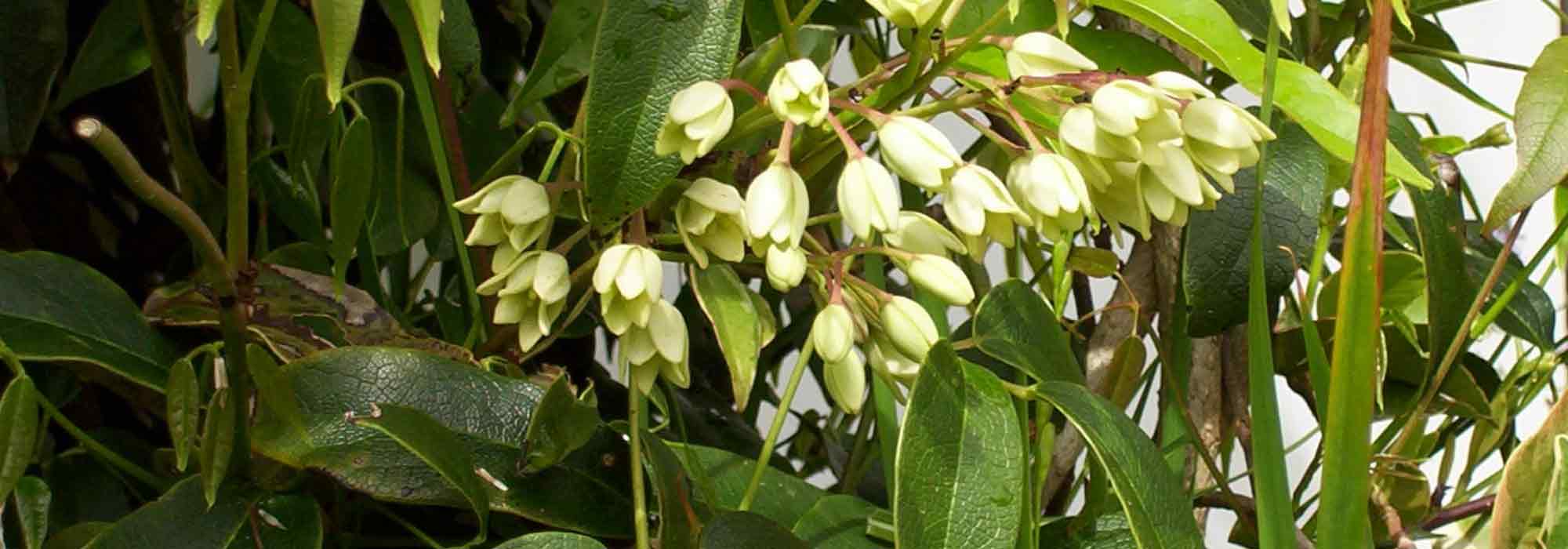
Holboellia: 7 successful pairing ideas
For all styles
Contents
Described for the first time in 1824, the genus Holboellia comprises climbing perennial plants native to the Himalayas. Still relatively unknown to gardeners, they mostly feature tough evergreen foliage supported by voluble stems and bloom in spring or early summer, depending on the climate and species.
The flowering of Holboellia latifolia and coriacea, also known as Chinese blue vine, is monoecious, meaning it bears distinct male and female flowers. These charming little flowers, about 2 cm in size, are clustered together. The male flowers are pale greenish-white, while the female flowers, delightfully fragrant, are a purplish-pink. Holboellia coriacea produces purple fruits, given sunny and warm summers. Moderately hardy (Zone 8a), these plants are nevertheless easy to grow in well-drained, rich, humus-bearing soil, in full sun or partial shade.
Discover our ideas and inspiration for successfully pairing Holboellias in the garden!
Holboellia in a trendy colour bed
It’s one of the trendy colours for 2022 in the garden: called “Mango sorbet”, it marks a return of soft and vibrant colours outdoors, with this bright orange in the spotlight, found in many plants. This colour pairs wonderfully with the Holboellia coriacea, with its dark green foliage and cream-white flowers. It kicks off the flowering season in April-May and can climb on lovely supports thanks to its tendrils.
It is happily associated with Kniphofia or Red Hot Pokers, particularly the variety ‘Fiery Fred’ with its striking orange graphic inflorescences. The delicate detail of the flowers of Hedychium spicatum, stunning perennial plants with an exotic look, flowering in September-October and the brightness of the Eschscholzia or California Poppies complete this vibrant picture.
You can also consider Rudbeckias Echinacea ‘Big Kahuna’ and their large, dazzling mango-orange flowers to bloom the composition all summer long. These elegant and graphic flowers can be integrated into contemporary gardens or invigorate borders needing a bit of renewal, in regions with a mild climate.
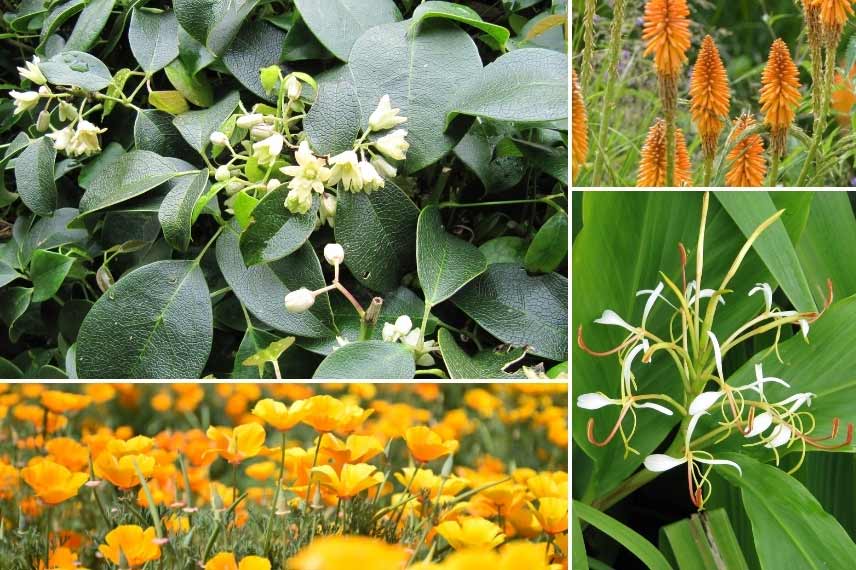
Holboellia (Leonora Enking – Flickr), Kniphofia Fiery Fred, Hedychium spicatum, Eschscholzia californica
Holboellia in a blue palette
Blue is also a trendy colour in the garden. Perfectly in harmony with the Holboellia angustifolia, latifolia or coriacea, it is embodied in the lavender-blue corollas of the Hardy Geranium ‘Brookside’, easy to grow and flowering from June to September, or in the spikes of the Perovskias, well-suited to southern gardens due to their drought resistance.
In the foreground of your border, plant masses of Catmint Nepeta faasenii with violet-blue flowers from June to September. Finally, clumps of Eryngium planum will develop their numerous flowers in azure blue heads throughout the summer and structure the display with their graphic appearance.
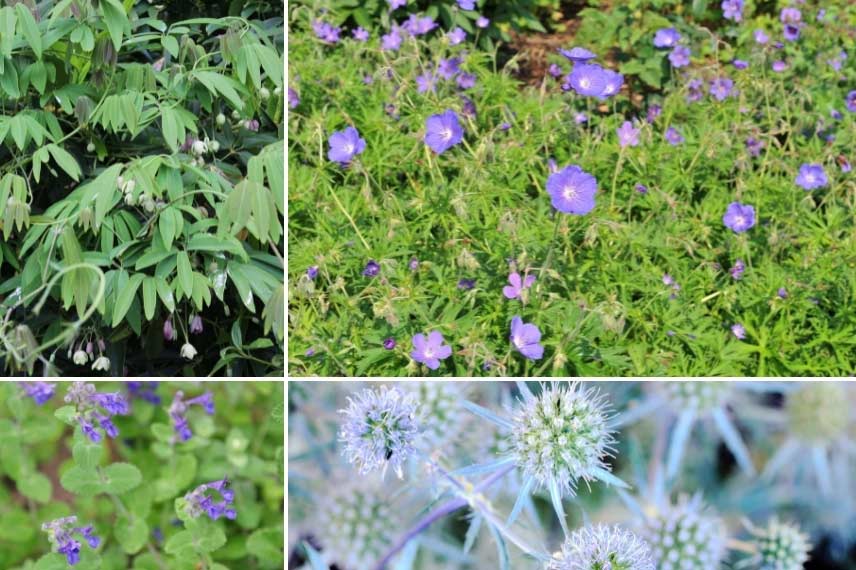
Holboellia angustifolia (Peganum, Flickr), Hardy Geranium ‘Brookside’, Nepeta faaseni and Eryngium planum
Discover other Holboellia
View all →Available in 1 sizes
Available in 1 sizes
Available in 1 sizes
Available in 1 sizes
Available in 1 sizes
Holboellia in an edible garden with unique flavours
A vigorous climbing plant, Holboellia coriacea should be planted at the base of a support to grow by clinging with its voluble stems. A trellis, a fence, or a pergola: it will climb to over 5m in height with a spread of 1m.
Today, gardens are becoming edible. This is fortunate because when exposed to heat and sunlight, Holboellia coriacea produces purple fruits resembling plums. To add new flavours to your garden, also plant a self-fertile Feijoa Acca sellowiana ‘Coolidge’, which produces delicious small vitamin-rich fruits known as Brazilian guavas in October-November under mild climates. You can also plant another edible climbing plant like the Kiwi arguta ‘Vitikiwi’ or Kiwaï, a self-fertile variety producing sweet, seedless fruits.
In the privileged climate of the Mediterranean coast or in pots, add the flavours of the Buddha’s Hand Citron Citrus medica var. ‘Sarcodactylis’. This citrus with curious fruits is valued for the unique fragrance of its zest, offering woody notes. It should be wintered in case of frost below -3°C.
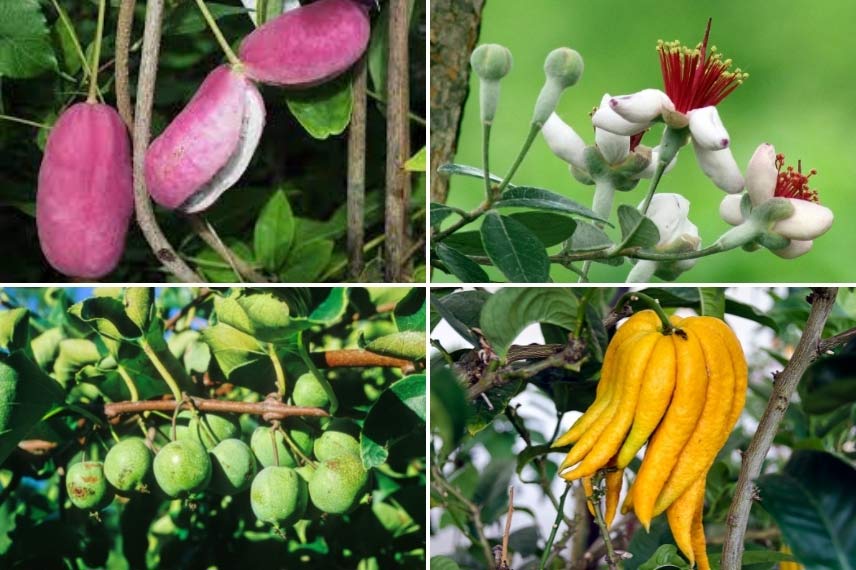
Fruits of Holboellia coriacea, Flower of Acca sellowiana ‘Coolidge’, Kiwi arguta ‘Vitikiwi’ and Citrus medica var. ‘Sarcodactylis’
Read also
10 climbing plants ideal for fencesHolboellia in a timeless, elegant, and graphic garden
The natural elegance of Holboellia can serve as a vertical cocoon in a garden that blends simplicity and elegance. Stretching their voluble branches over lovely trellises fixed to the wall, they can be accompanied at the base by generous clumps of Miscanthus sinensis ‘Gracillimus‘, with its tender green and clean lines. The flowering of lovely white spikes from Tiarella cordifolia, from April to June, will bring light and an equally elegant touch.
To deliberately enhance the scene’s graphic quality, plant at the base masses of black Ophiopogon Ophiopogon planiscapus ‘Nigrescens’, punctuated by Pittosporum tenuifolium.
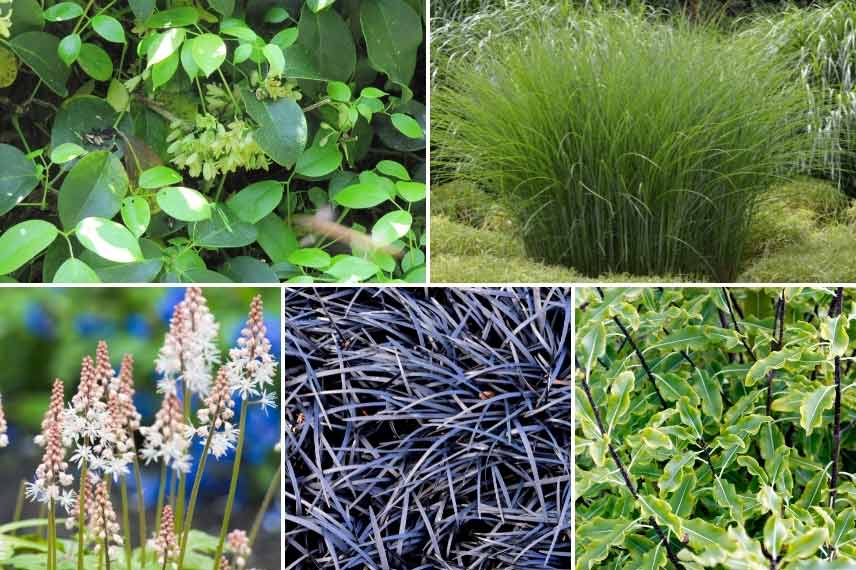
Holboellia (Leonora Enking – Flickr), Miscanthus sinensis ‘Gracillimus’, Tiarella cordifolia, Ophiopogon planiscapus ‘Nigrescens’ and Pittosporum tenuifolium
Holboellia in a naturalistic border
The naturalistic garden is inspired by the fields and flowering meadows of the countryside. Bring these little pieces of paradise into your garden for visual delight and the joy of picking beautiful, rustic-looking bouquets! Simplicity, colours, and cheerful chaos… the Holboellia coriacea can tick all the boxes by climbing on a rustic wooden trellis or fence made from branches. It can also scale a tree or climb up a hazel arch.
For its soft pink summer flowering, plant the Bergamot pink Monarda didyma ‘Croftway Pink’. Its crumpled leaves release a refreshing citrus scent. Pair it with Perovskia atriplicifolia ‘Blue Spire’ whose lavender blue beautifully complements the pink of the Monardas and the almost purple spikes of Sanguisorba menziesii. Beautiful masses of Phlomis russeliana or Phlomis fruticosa with its sunny yellow flowers, and you have a natural and very easy display, accessible to all gardeners!
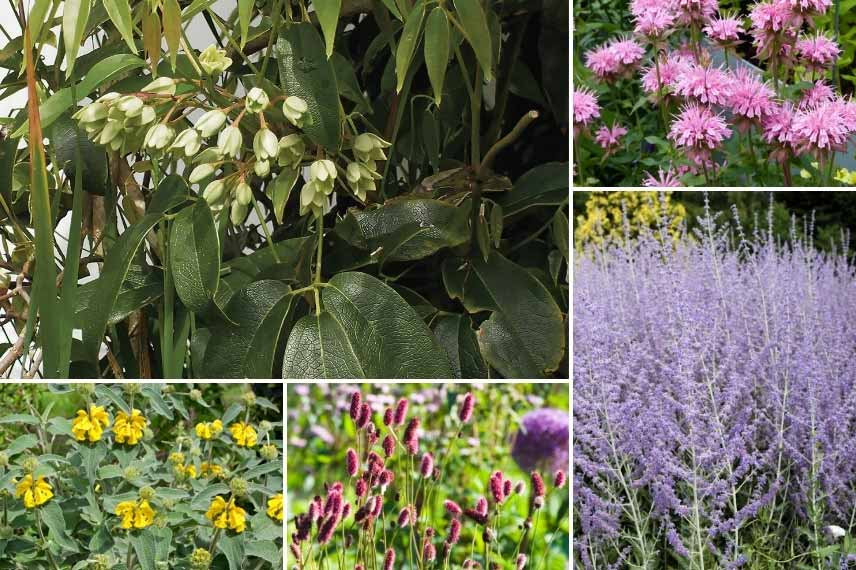
Holboellia Coriacea, Monardia croftway ‘Pink’, Perovskia, Sanguisorba menziesii, Phlomis fruticosa
Holboellia in an urban garden
The urban garden style is heavily influenced by the built environment in which it is situated. In cities, outdoor spaces are often small, and green walls serve as true elements of urban ecology. In this context, Holboellia latifolia and Holboellia coriacea will grow upwards with the available space, trained in the sun on a wooden or concrete trellis, which is both economical and aesthetically pleasing. For a graphic effect that is quick and (almost) maintenance-free, plant medium-growing grasses such as Pennisetum alopecuroides ‘Hameln’. In shaded areas by walls, install foliage plants such as the bright Hosta ‘Big Daddy’.
Also interesting for their sunny appearance, common Alchemilla Alchemilla molliswill carpet the base of the climbers. Finally, to add colour through foliage and enhance the graphic atmosphere, plant Blood Grass Imperata cylindrica ‘Red Baron’, a grass with stunning foliage that turns a purplish red in summer and Heuchera ‘Green Spice’. This low-maintenance perennial will delight you with the changing and contrasting colours of its foliage.
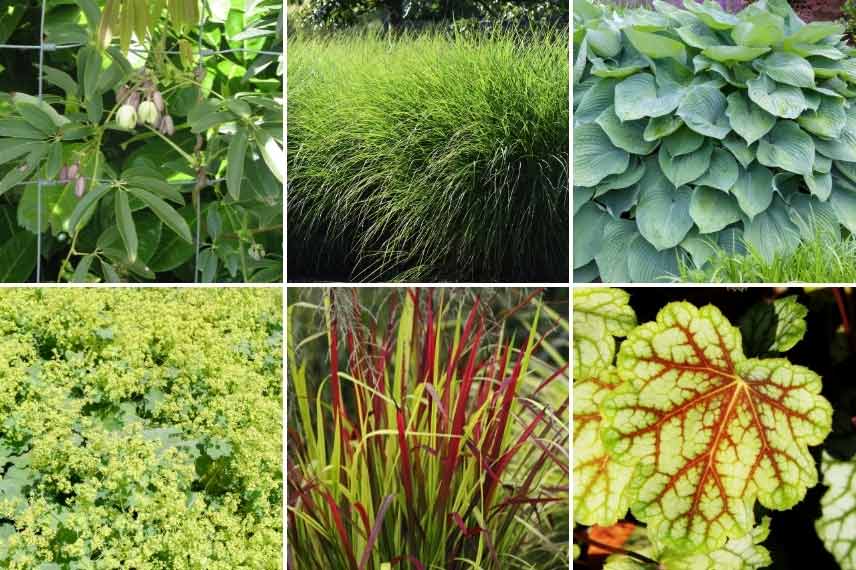
Holboellia angustifolia, Pennisetum Alopecuroides ‘Hameln’, Hosta Big Daddy, Alchemilla mollis, Imperata Rubra cylindrica ‘Red Baron’, Heuchera ‘Green Spice’
Holboellia in a 'Jungle' garden
Holboellia latifolia and Holboellia coriacea exhibit lush foliage and delicate flowering. They can climb up to 5 m on a trellis or support and can serve as a backdrop for a tropical-themed scene, composed of a patchwork of remarkable foliage.
The giant melianthus Melianthus major fits into this category, with its architectural habit and mass of impressive leaves giving it the appearance of a giant fern. Like the Holboellia, Melianthus loves the sun and showcases brown-red spike-like inflorescences with a honey scent in late spring. In the background, the palm Trachycarpus fortunei will elegantly raise its trunk and large fan-shaped leaves. It is easy to grow and cold-resistant.
In summer, the feathery flowers of Astilbe thunbergii ‘Prof. van der Wielen’ will balance these impressive foliage with their lightness and brightness. This beautiful and vigorous perennial is easy to grow and enjoys heavy, moist soils. In this exotic atmosphere, you might also consider planting the banana plant Musa basjoo or the false aralia Fatsia japonica.
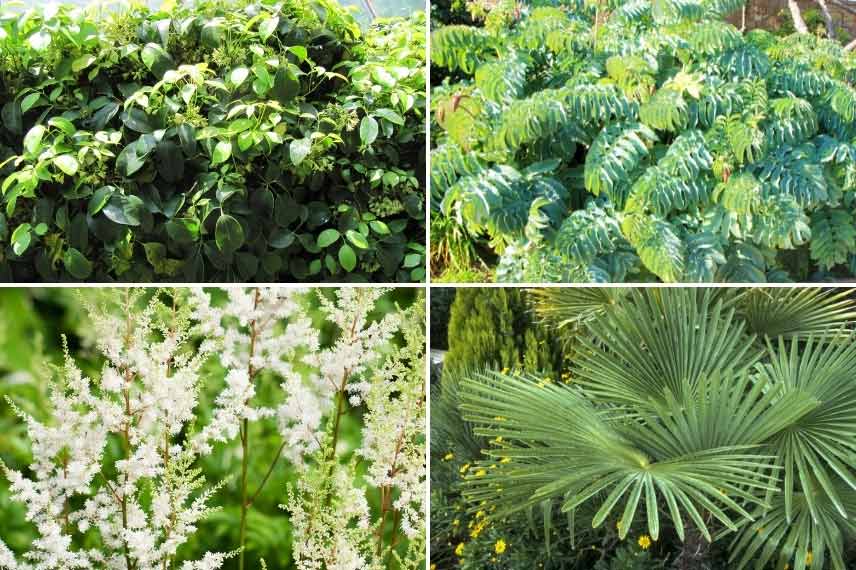
Holboellia (Leonora Enking – Flickr), Melianthus major, Astilbe thunbergii ‘Prof. van der Wielen’ and Trachycarpus fortunei
- Subscribe!
- Contents
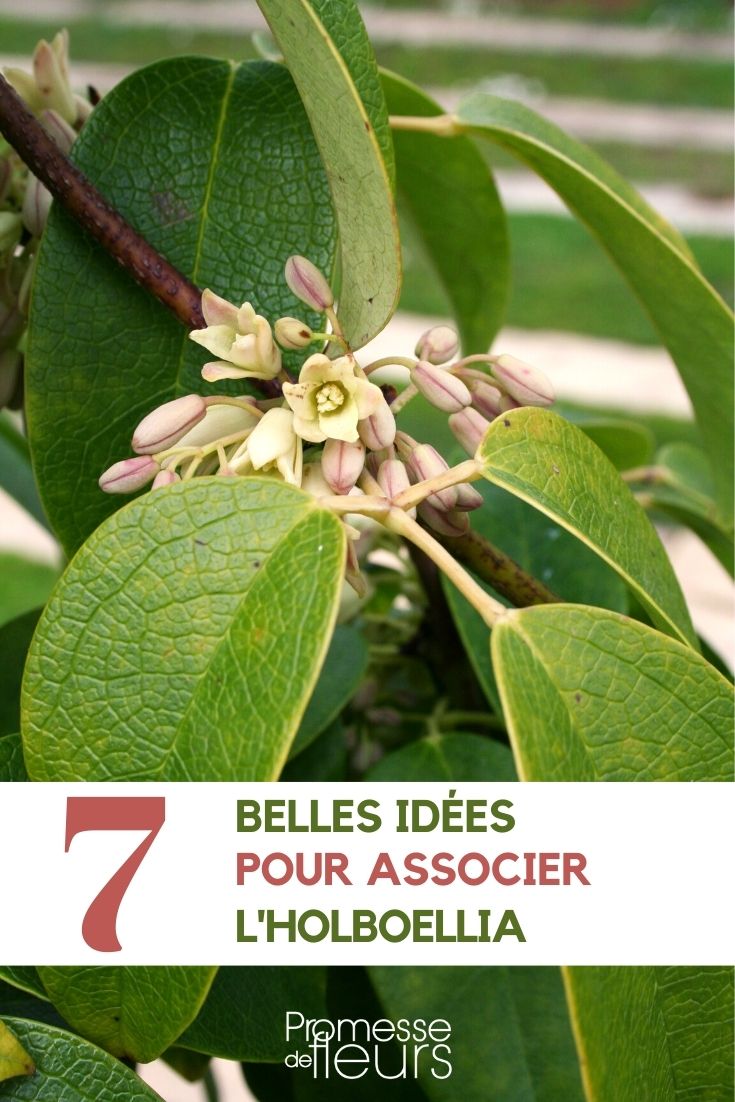

































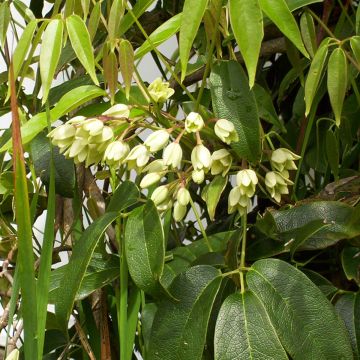


Comments